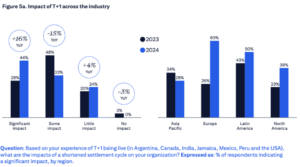The switch to a shortened settlement cycle in North America has had a bigger effect than expected, with 44% of market participants reported to being significantly impacted by the transition – up from 28% a year ago.
 This is according to a new report from Citi, which tracked the impact of a shortened settlement cycle across the world.
This is according to a new report from Citi, which tracked the impact of a shortened settlement cycle across the world.
The survey found that the transition has been particularly strenuous for European participants – 60% of which reporting a significant impact to their operations as a result of T+1. This figure has more than doubled from 2023.
For specific affected sectors, securities lending remains one of the most strongly impacted activities — jumping from 33% to 50% this year. Funding has also seen notable impact — albeit with an imbalance across the sell-side and buy-sides. For brokers and custodians, the single biggest impact of T+1 has been the 30% reduction in clearing margin, with 80% of the sell-side seeing this development as strongly impactful to their businesses.
Additionally, over half (52%) of banks and brokers reported that the transition has had a significant impact on their headcounts and staffing levels. The whitepaper added that sell-side organisations have found themselves exposed to large volumes of manual processing and exception handling, triggered by clients.
 Okan Pekin, head of securities services at Citi, said: “The move to T+1 has taken centre stage in the post-trade industry over the last few years. Our latest whitepaper – the largest since its inception in 2021 – focuses on the next frontier for the industry which is the growing applicability of technologies. This includes distributed ledger technology and digital assets, and the significant potential for tokenisation to scale. These developments will continue to transform the securities landscape as we continue to move towards shorter settlement cycles across multiple markets worldwide.”
Okan Pekin, head of securities services at Citi, said: “The move to T+1 has taken centre stage in the post-trade industry over the last few years. Our latest whitepaper – the largest since its inception in 2021 – focuses on the next frontier for the industry which is the growing applicability of technologies. This includes distributed ledger technology and digital assets, and the significant potential for tokenisation to scale. These developments will continue to transform the securities landscape as we continue to move towards shorter settlement cycles across multiple markets worldwide.”
The whitepaper polled close to 500 market participants across the buy- and sell-side, and incorporates insights from 14 financial market infrastructures (FMIs). The report also includes an regional view of the industry across Asia Pacific, Europe, North America, and Latin America. A full copy of the study can be found here.